LWD101 - Ethical Decision Making Framework: A Case Study Analysis
VerifiedAdded on 2023/06/07
|10
|2821
|443
Report
AI Summary
This report applies an ethical decision-making framework to a case involving a 16-year-old patient named Stella, who presents with concerns about potential pregnancy and possible domestic violence. The analysis identifies key issues such as teenage pregnancy, confidentiality, and potential abuse. It evaluates these issues using the ICN Code of Ethics and ethical principles like autonomy, beneficence, non-maleficence, and justice. The report also addresses relevant legal issues, including civil negligence and duty of care. Furthermore, it outlines actions based on the NMBA Code of Conduct, including legal compliance, person-centered practice, and culturally safe practice. Finally, the report discusses implementation steps such as home visits, community-based advocacy, sexual education, and counseling, while assessing the outcomes of these interventions in relation to ethical principles and legal obligations.
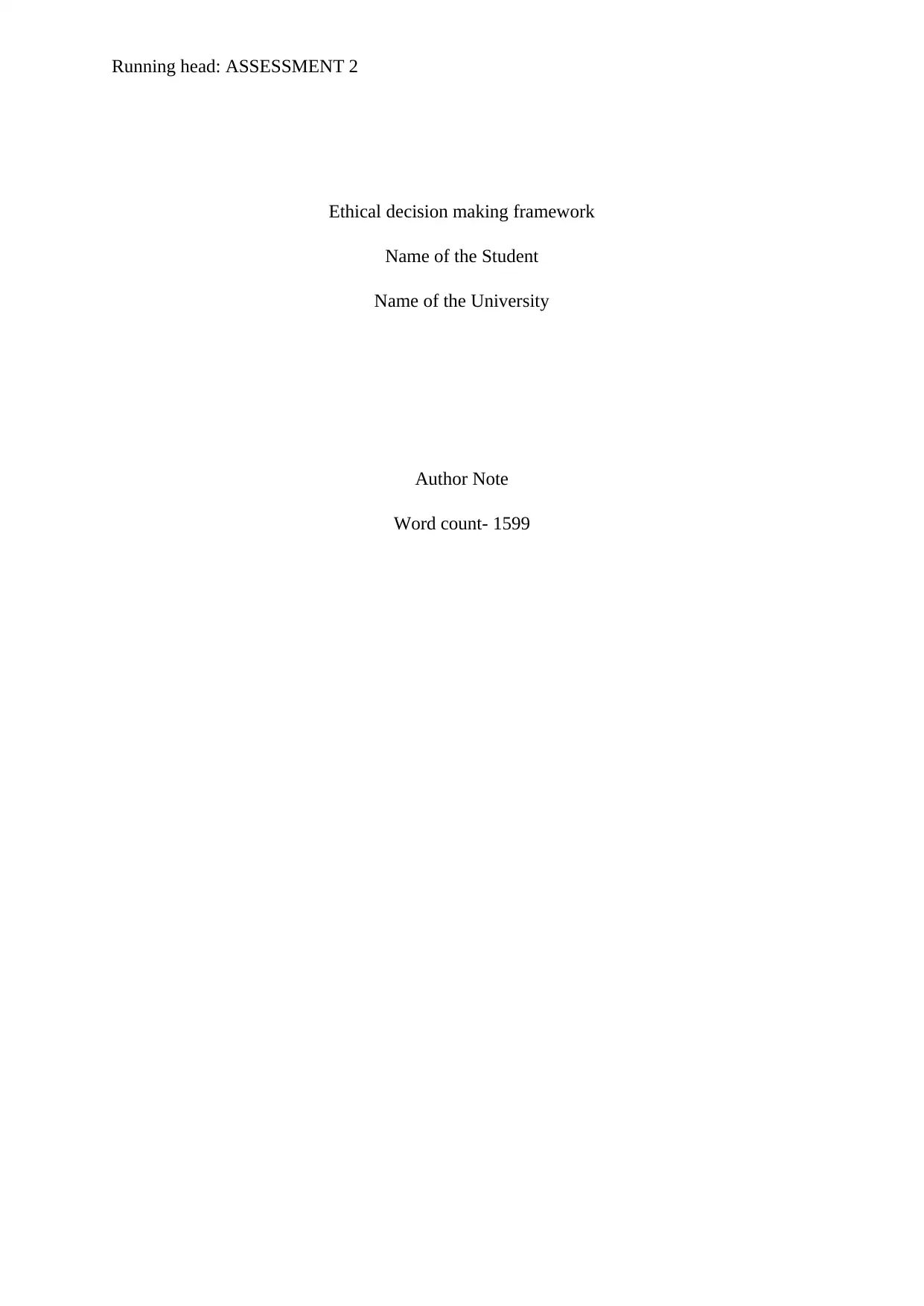
Running head: ASSESSMENT 2
Ethical decision making framework
Name of the Student
Name of the University
Author Note
Word count- 1599
Ethical decision making framework
Name of the Student
Name of the University
Author Note
Word count- 1599
Paraphrase This Document
Need a fresh take? Get an instant paraphrase of this document with our AI Paraphraser
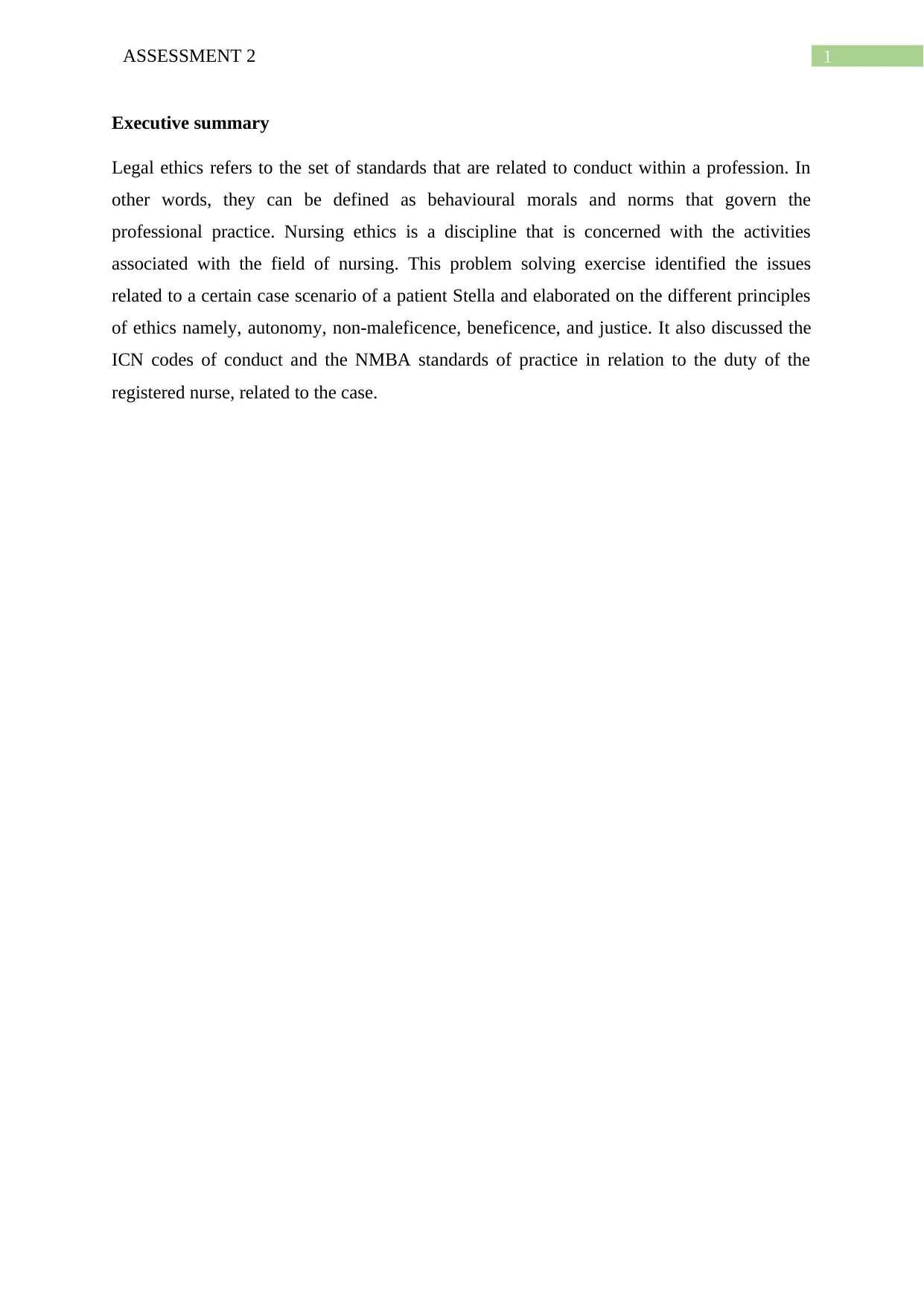
1ASSESSMENT 2
Executive summary
Legal ethics refers to the set of standards that are related to conduct within a profession. In
other words, they can be defined as behavioural morals and norms that govern the
professional practice. Nursing ethics is a discipline that is concerned with the activities
associated with the field of nursing. This problem solving exercise identified the issues
related to a certain case scenario of a patient Stella and elaborated on the different principles
of ethics namely, autonomy, non-maleficence, beneficence, and justice. It also discussed the
ICN codes of conduct and the NMBA standards of practice in relation to the duty of the
registered nurse, related to the case.
Executive summary
Legal ethics refers to the set of standards that are related to conduct within a profession. In
other words, they can be defined as behavioural morals and norms that govern the
professional practice. Nursing ethics is a discipline that is concerned with the activities
associated with the field of nursing. This problem solving exercise identified the issues
related to a certain case scenario of a patient Stella and elaborated on the different principles
of ethics namely, autonomy, non-maleficence, beneficence, and justice. It also discussed the
ICN codes of conduct and the NMBA standards of practice in relation to the duty of the
registered nurse, related to the case.
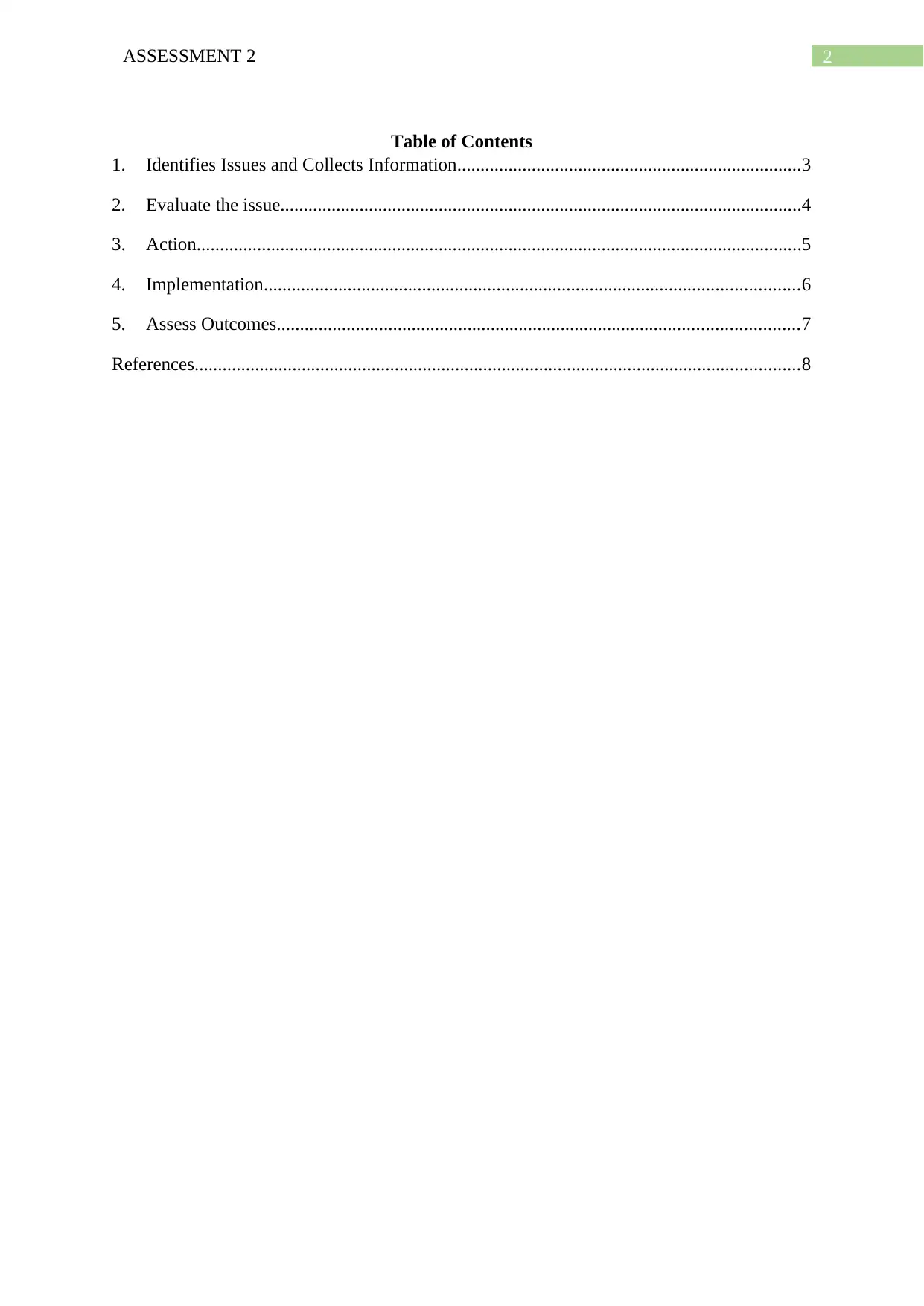
2ASSESSMENT 2
Table of Contents
1. Identifies Issues and Collects Information..........................................................................3
2. Evaluate the issue................................................................................................................4
3. Action..................................................................................................................................5
4. Implementation...................................................................................................................6
5. Assess Outcomes................................................................................................................7
References..................................................................................................................................8
Table of Contents
1. Identifies Issues and Collects Information..........................................................................3
2. Evaluate the issue................................................................................................................4
3. Action..................................................................................................................................5
4. Implementation...................................................................................................................6
5. Assess Outcomes................................................................................................................7
References..................................................................................................................................8
⊘ This is a preview!⊘
Do you want full access?
Subscribe today to unlock all pages.

Trusted by 1+ million students worldwide
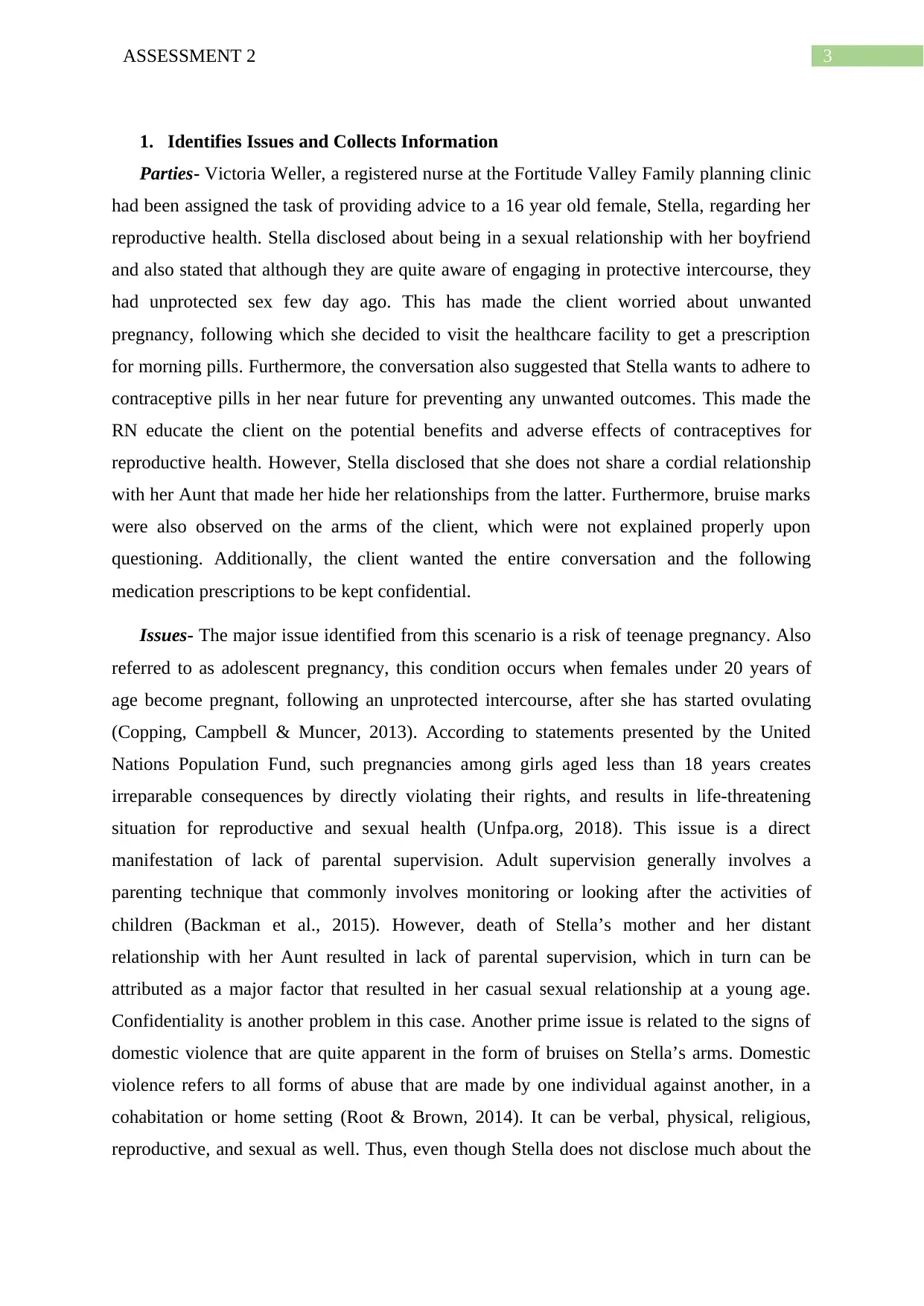
3ASSESSMENT 2
1. Identifies Issues and Collects Information
Parties- Victoria Weller, a registered nurse at the Fortitude Valley Family planning clinic
had been assigned the task of providing advice to a 16 year old female, Stella, regarding her
reproductive health. Stella disclosed about being in a sexual relationship with her boyfriend
and also stated that although they are quite aware of engaging in protective intercourse, they
had unprotected sex few day ago. This has made the client worried about unwanted
pregnancy, following which she decided to visit the healthcare facility to get a prescription
for morning pills. Furthermore, the conversation also suggested that Stella wants to adhere to
contraceptive pills in her near future for preventing any unwanted outcomes. This made the
RN educate the client on the potential benefits and adverse effects of contraceptives for
reproductive health. However, Stella disclosed that she does not share a cordial relationship
with her Aunt that made her hide her relationships from the latter. Furthermore, bruise marks
were also observed on the arms of the client, which were not explained properly upon
questioning. Additionally, the client wanted the entire conversation and the following
medication prescriptions to be kept confidential.
Issues- The major issue identified from this scenario is a risk of teenage pregnancy. Also
referred to as adolescent pregnancy, this condition occurs when females under 20 years of
age become pregnant, following an unprotected intercourse, after she has started ovulating
(Copping, Campbell & Muncer, 2013). According to statements presented by the United
Nations Population Fund, such pregnancies among girls aged less than 18 years creates
irreparable consequences by directly violating their rights, and results in life-threatening
situation for reproductive and sexual health (Unfpa.org, 2018). This issue is a direct
manifestation of lack of parental supervision. Adult supervision generally involves a
parenting technique that commonly involves monitoring or looking after the activities of
children (Backman et al., 2015). However, death of Stella’s mother and her distant
relationship with her Aunt resulted in lack of parental supervision, which in turn can be
attributed as a major factor that resulted in her casual sexual relationship at a young age.
Confidentiality is another problem in this case. Another prime issue is related to the signs of
domestic violence that are quite apparent in the form of bruises on Stella’s arms. Domestic
violence refers to all forms of abuse that are made by one individual against another, in a
cohabitation or home setting (Root & Brown, 2014). It can be verbal, physical, religious,
reproductive, and sexual as well. Thus, even though Stella does not disclose much about the
1. Identifies Issues and Collects Information
Parties- Victoria Weller, a registered nurse at the Fortitude Valley Family planning clinic
had been assigned the task of providing advice to a 16 year old female, Stella, regarding her
reproductive health. Stella disclosed about being in a sexual relationship with her boyfriend
and also stated that although they are quite aware of engaging in protective intercourse, they
had unprotected sex few day ago. This has made the client worried about unwanted
pregnancy, following which she decided to visit the healthcare facility to get a prescription
for morning pills. Furthermore, the conversation also suggested that Stella wants to adhere to
contraceptive pills in her near future for preventing any unwanted outcomes. This made the
RN educate the client on the potential benefits and adverse effects of contraceptives for
reproductive health. However, Stella disclosed that she does not share a cordial relationship
with her Aunt that made her hide her relationships from the latter. Furthermore, bruise marks
were also observed on the arms of the client, which were not explained properly upon
questioning. Additionally, the client wanted the entire conversation and the following
medication prescriptions to be kept confidential.
Issues- The major issue identified from this scenario is a risk of teenage pregnancy. Also
referred to as adolescent pregnancy, this condition occurs when females under 20 years of
age become pregnant, following an unprotected intercourse, after she has started ovulating
(Copping, Campbell & Muncer, 2013). According to statements presented by the United
Nations Population Fund, such pregnancies among girls aged less than 18 years creates
irreparable consequences by directly violating their rights, and results in life-threatening
situation for reproductive and sexual health (Unfpa.org, 2018). This issue is a direct
manifestation of lack of parental supervision. Adult supervision generally involves a
parenting technique that commonly involves monitoring or looking after the activities of
children (Backman et al., 2015). However, death of Stella’s mother and her distant
relationship with her Aunt resulted in lack of parental supervision, which in turn can be
attributed as a major factor that resulted in her casual sexual relationship at a young age.
Confidentiality is another problem in this case. Another prime issue is related to the signs of
domestic violence that are quite apparent in the form of bruises on Stella’s arms. Domestic
violence refers to all forms of abuse that are made by one individual against another, in a
cohabitation or home setting (Root & Brown, 2014). It can be verbal, physical, religious,
reproductive, and sexual as well. Thus, even though Stella does not disclose much about the
Paraphrase This Document
Need a fresh take? Get an instant paraphrase of this document with our AI Paraphraser
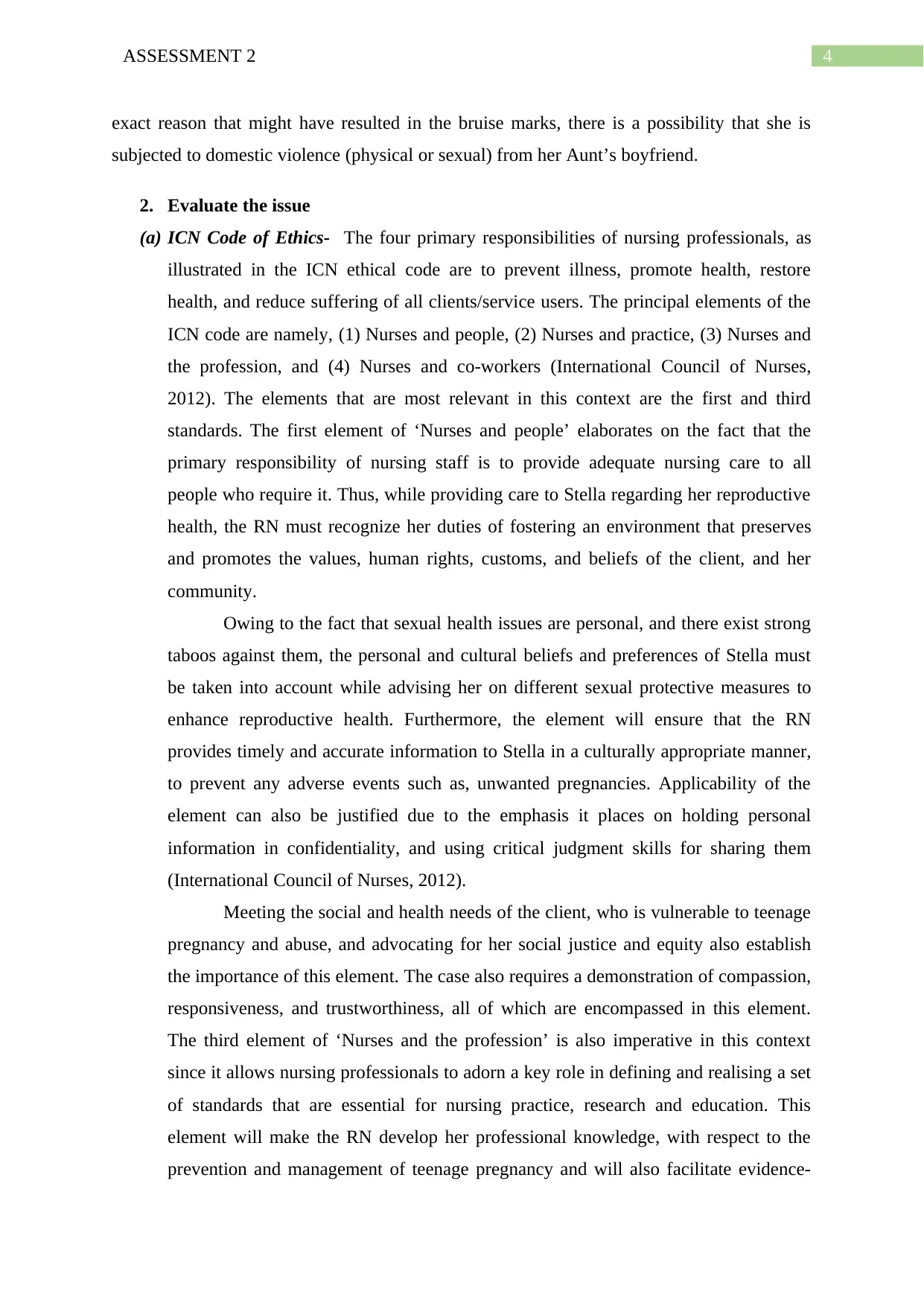
4ASSESSMENT 2
exact reason that might have resulted in the bruise marks, there is a possibility that she is
subjected to domestic violence (physical or sexual) from her Aunt’s boyfriend.
2. Evaluate the issue
(a) ICN Code of Ethics- The four primary responsibilities of nursing professionals, as
illustrated in the ICN ethical code are to prevent illness, promote health, restore
health, and reduce suffering of all clients/service users. The principal elements of the
ICN code are namely, (1) Nurses and people, (2) Nurses and practice, (3) Nurses and
the profession, and (4) Nurses and co-workers (International Council of Nurses,
2012). The elements that are most relevant in this context are the first and third
standards. The first element of ‘Nurses and people’ elaborates on the fact that the
primary responsibility of nursing staff is to provide adequate nursing care to all
people who require it. Thus, while providing care to Stella regarding her reproductive
health, the RN must recognize her duties of fostering an environment that preserves
and promotes the values, human rights, customs, and beliefs of the client, and her
community.
Owing to the fact that sexual health issues are personal, and there exist strong
taboos against them, the personal and cultural beliefs and preferences of Stella must
be taken into account while advising her on different sexual protective measures to
enhance reproductive health. Furthermore, the element will ensure that the RN
provides timely and accurate information to Stella in a culturally appropriate manner,
to prevent any adverse events such as, unwanted pregnancies. Applicability of the
element can also be justified due to the emphasis it places on holding personal
information in confidentiality, and using critical judgment skills for sharing them
(International Council of Nurses, 2012).
Meeting the social and health needs of the client, who is vulnerable to teenage
pregnancy and abuse, and advocating for her social justice and equity also establish
the importance of this element. The case also requires a demonstration of compassion,
responsiveness, and trustworthiness, all of which are encompassed in this element.
The third element of ‘Nurses and the profession’ is also imperative in this context
since it allows nursing professionals to adorn a key role in defining and realising a set
of standards that are essential for nursing practice, research and education. This
element will make the RN develop her professional knowledge, with respect to the
prevention and management of teenage pregnancy and will also facilitate evidence-
exact reason that might have resulted in the bruise marks, there is a possibility that she is
subjected to domestic violence (physical or sexual) from her Aunt’s boyfriend.
2. Evaluate the issue
(a) ICN Code of Ethics- The four primary responsibilities of nursing professionals, as
illustrated in the ICN ethical code are to prevent illness, promote health, restore
health, and reduce suffering of all clients/service users. The principal elements of the
ICN code are namely, (1) Nurses and people, (2) Nurses and practice, (3) Nurses and
the profession, and (4) Nurses and co-workers (International Council of Nurses,
2012). The elements that are most relevant in this context are the first and third
standards. The first element of ‘Nurses and people’ elaborates on the fact that the
primary responsibility of nursing staff is to provide adequate nursing care to all
people who require it. Thus, while providing care to Stella regarding her reproductive
health, the RN must recognize her duties of fostering an environment that preserves
and promotes the values, human rights, customs, and beliefs of the client, and her
community.
Owing to the fact that sexual health issues are personal, and there exist strong
taboos against them, the personal and cultural beliefs and preferences of Stella must
be taken into account while advising her on different sexual protective measures to
enhance reproductive health. Furthermore, the element will ensure that the RN
provides timely and accurate information to Stella in a culturally appropriate manner,
to prevent any adverse events such as, unwanted pregnancies. Applicability of the
element can also be justified due to the emphasis it places on holding personal
information in confidentiality, and using critical judgment skills for sharing them
(International Council of Nurses, 2012).
Meeting the social and health needs of the client, who is vulnerable to teenage
pregnancy and abuse, and advocating for her social justice and equity also establish
the importance of this element. The case also requires a demonstration of compassion,
responsiveness, and trustworthiness, all of which are encompassed in this element.
The third element of ‘Nurses and the profession’ is also imperative in this context
since it allows nursing professionals to adorn a key role in defining and realising a set
of standards that are essential for nursing practice, research and education. This
element will make the RN develop her professional knowledge, with respect to the
prevention and management of teenage pregnancy and will also facilitate evidence-
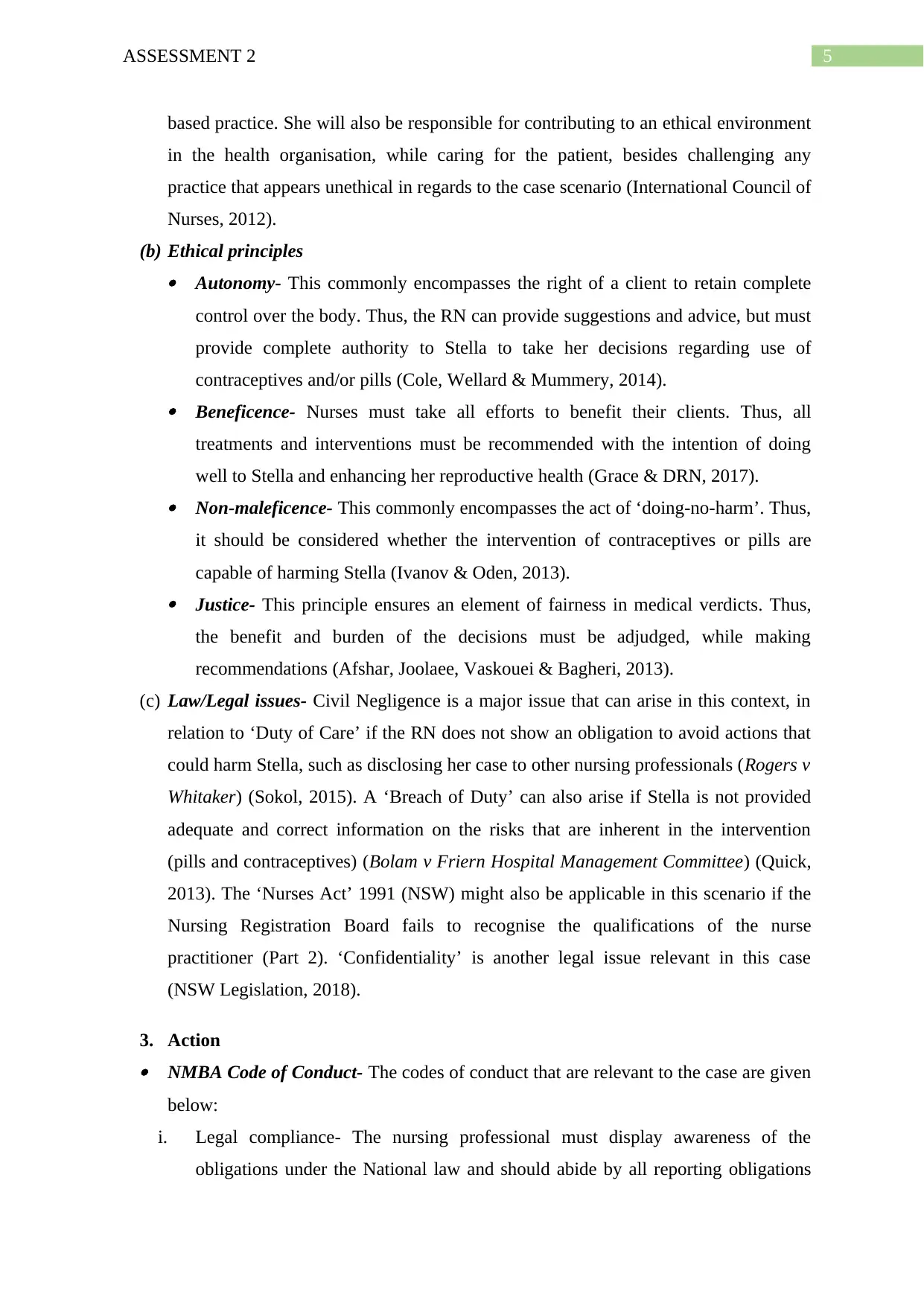
5ASSESSMENT 2
based practice. She will also be responsible for contributing to an ethical environment
in the health organisation, while caring for the patient, besides challenging any
practice that appears unethical in regards to the case scenario (International Council of
Nurses, 2012).
(b) Ethical principles
Autonomy- This commonly encompasses the right of a client to retain complete
control over the body. Thus, the RN can provide suggestions and advice, but must
provide complete authority to Stella to take her decisions regarding use of
contraceptives and/or pills (Cole, Wellard & Mummery, 2014).
Beneficence- Nurses must take all efforts to benefit their clients. Thus, all
treatments and interventions must be recommended with the intention of doing
well to Stella and enhancing her reproductive health (Grace & DRN, 2017).
Non-maleficence- This commonly encompasses the act of ‘doing-no-harm’. Thus,
it should be considered whether the intervention of contraceptives or pills are
capable of harming Stella (Ivanov & Oden, 2013).
Justice- This principle ensures an element of fairness in medical verdicts. Thus,
the benefit and burden of the decisions must be adjudged, while making
recommendations (Afshar, Joolaee, Vaskouei & Bagheri, 2013).
(c) Law/Legal issues- Civil Negligence is a major issue that can arise in this context, in
relation to ‘Duty of Care’ if the RN does not show an obligation to avoid actions that
could harm Stella, such as disclosing her case to other nursing professionals (Rogers v
Whitaker) (Sokol, 2015). A ‘Breach of Duty’ can also arise if Stella is not provided
adequate and correct information on the risks that are inherent in the intervention
(pills and contraceptives) (Bolam v Friern Hospital Management Committee) (Quick,
2013). The ‘Nurses Act’ 1991 (NSW) might also be applicable in this scenario if the
Nursing Registration Board fails to recognise the qualifications of the nurse
practitioner (Part 2). ‘Confidentiality’ is another legal issue relevant in this case
(NSW Legislation, 2018).
3. Action NMBA Code of Conduct- The codes of conduct that are relevant to the case are given
below:
i. Legal compliance- The nursing professional must display awareness of the
obligations under the National law and should abide by all reporting obligations
based practice. She will also be responsible for contributing to an ethical environment
in the health organisation, while caring for the patient, besides challenging any
practice that appears unethical in regards to the case scenario (International Council of
Nurses, 2012).
(b) Ethical principles
Autonomy- This commonly encompasses the right of a client to retain complete
control over the body. Thus, the RN can provide suggestions and advice, but must
provide complete authority to Stella to take her decisions regarding use of
contraceptives and/or pills (Cole, Wellard & Mummery, 2014).
Beneficence- Nurses must take all efforts to benefit their clients. Thus, all
treatments and interventions must be recommended with the intention of doing
well to Stella and enhancing her reproductive health (Grace & DRN, 2017).
Non-maleficence- This commonly encompasses the act of ‘doing-no-harm’. Thus,
it should be considered whether the intervention of contraceptives or pills are
capable of harming Stella (Ivanov & Oden, 2013).
Justice- This principle ensures an element of fairness in medical verdicts. Thus,
the benefit and burden of the decisions must be adjudged, while making
recommendations (Afshar, Joolaee, Vaskouei & Bagheri, 2013).
(c) Law/Legal issues- Civil Negligence is a major issue that can arise in this context, in
relation to ‘Duty of Care’ if the RN does not show an obligation to avoid actions that
could harm Stella, such as disclosing her case to other nursing professionals (Rogers v
Whitaker) (Sokol, 2015). A ‘Breach of Duty’ can also arise if Stella is not provided
adequate and correct information on the risks that are inherent in the intervention
(pills and contraceptives) (Bolam v Friern Hospital Management Committee) (Quick,
2013). The ‘Nurses Act’ 1991 (NSW) might also be applicable in this scenario if the
Nursing Registration Board fails to recognise the qualifications of the nurse
practitioner (Part 2). ‘Confidentiality’ is another legal issue relevant in this case
(NSW Legislation, 2018).
3. Action NMBA Code of Conduct- The codes of conduct that are relevant to the case are given
below:
i. Legal compliance- The nursing professional must display awareness of the
obligations under the National law and should abide by all reporting obligations
⊘ This is a preview!⊘
Do you want full access?
Subscribe today to unlock all pages.

Trusted by 1+ million students worldwide
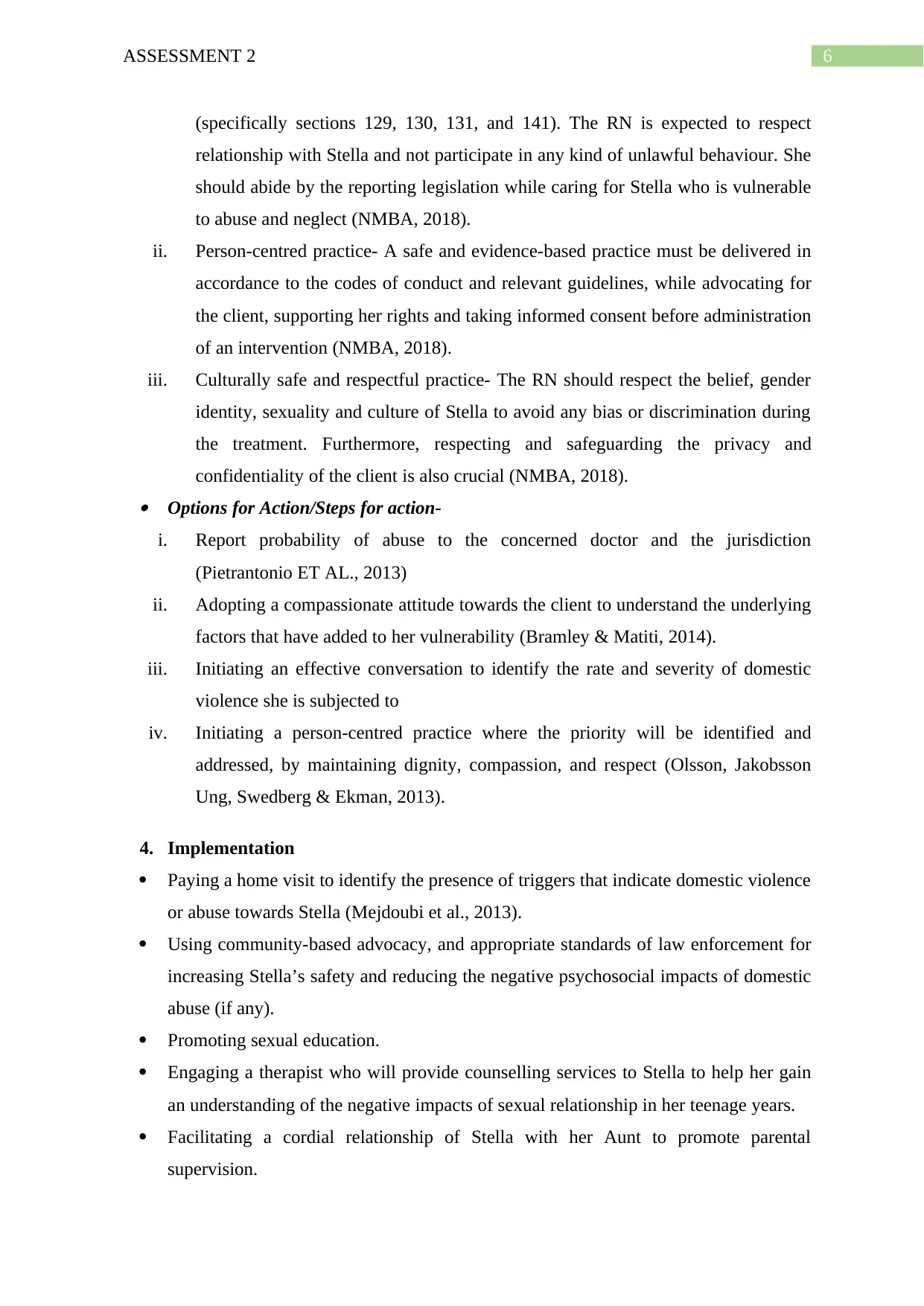
6ASSESSMENT 2
(specifically sections 129, 130, 131, and 141). The RN is expected to respect
relationship with Stella and not participate in any kind of unlawful behaviour. She
should abide by the reporting legislation while caring for Stella who is vulnerable
to abuse and neglect (NMBA, 2018).
ii. Person-centred practice- A safe and evidence-based practice must be delivered in
accordance to the codes of conduct and relevant guidelines, while advocating for
the client, supporting her rights and taking informed consent before administration
of an intervention (NMBA, 2018).
iii. Culturally safe and respectful practice- The RN should respect the belief, gender
identity, sexuality and culture of Stella to avoid any bias or discrimination during
the treatment. Furthermore, respecting and safeguarding the privacy and
confidentiality of the client is also crucial (NMBA, 2018). Options for Action/Steps for action-
i. Report probability of abuse to the concerned doctor and the jurisdiction
(Pietrantonio ET AL., 2013)
ii. Adopting a compassionate attitude towards the client to understand the underlying
factors that have added to her vulnerability (Bramley & Matiti, 2014).
iii. Initiating an effective conversation to identify the rate and severity of domestic
violence she is subjected to
iv. Initiating a person-centred practice where the priority will be identified and
addressed, by maintaining dignity, compassion, and respect (Olsson, Jakobsson
Ung, Swedberg & Ekman, 2013).
4. Implementation
Paying a home visit to identify the presence of triggers that indicate domestic violence
or abuse towards Stella (Mejdoubi et al., 2013).
Using community-based advocacy, and appropriate standards of law enforcement for
increasing Stella’s safety and reducing the negative psychosocial impacts of domestic
abuse (if any).
Promoting sexual education.
Engaging a therapist who will provide counselling services to Stella to help her gain
an understanding of the negative impacts of sexual relationship in her teenage years.
Facilitating a cordial relationship of Stella with her Aunt to promote parental
supervision.
(specifically sections 129, 130, 131, and 141). The RN is expected to respect
relationship with Stella and not participate in any kind of unlawful behaviour. She
should abide by the reporting legislation while caring for Stella who is vulnerable
to abuse and neglect (NMBA, 2018).
ii. Person-centred practice- A safe and evidence-based practice must be delivered in
accordance to the codes of conduct and relevant guidelines, while advocating for
the client, supporting her rights and taking informed consent before administration
of an intervention (NMBA, 2018).
iii. Culturally safe and respectful practice- The RN should respect the belief, gender
identity, sexuality and culture of Stella to avoid any bias or discrimination during
the treatment. Furthermore, respecting and safeguarding the privacy and
confidentiality of the client is also crucial (NMBA, 2018). Options for Action/Steps for action-
i. Report probability of abuse to the concerned doctor and the jurisdiction
(Pietrantonio ET AL., 2013)
ii. Adopting a compassionate attitude towards the client to understand the underlying
factors that have added to her vulnerability (Bramley & Matiti, 2014).
iii. Initiating an effective conversation to identify the rate and severity of domestic
violence she is subjected to
iv. Initiating a person-centred practice where the priority will be identified and
addressed, by maintaining dignity, compassion, and respect (Olsson, Jakobsson
Ung, Swedberg & Ekman, 2013).
4. Implementation
Paying a home visit to identify the presence of triggers that indicate domestic violence
or abuse towards Stella (Mejdoubi et al., 2013).
Using community-based advocacy, and appropriate standards of law enforcement for
increasing Stella’s safety and reducing the negative psychosocial impacts of domestic
abuse (if any).
Promoting sexual education.
Engaging a therapist who will provide counselling services to Stella to help her gain
an understanding of the negative impacts of sexual relationship in her teenage years.
Facilitating a cordial relationship of Stella with her Aunt to promote parental
supervision.
Paraphrase This Document
Need a fresh take? Get an instant paraphrase of this document with our AI Paraphraser
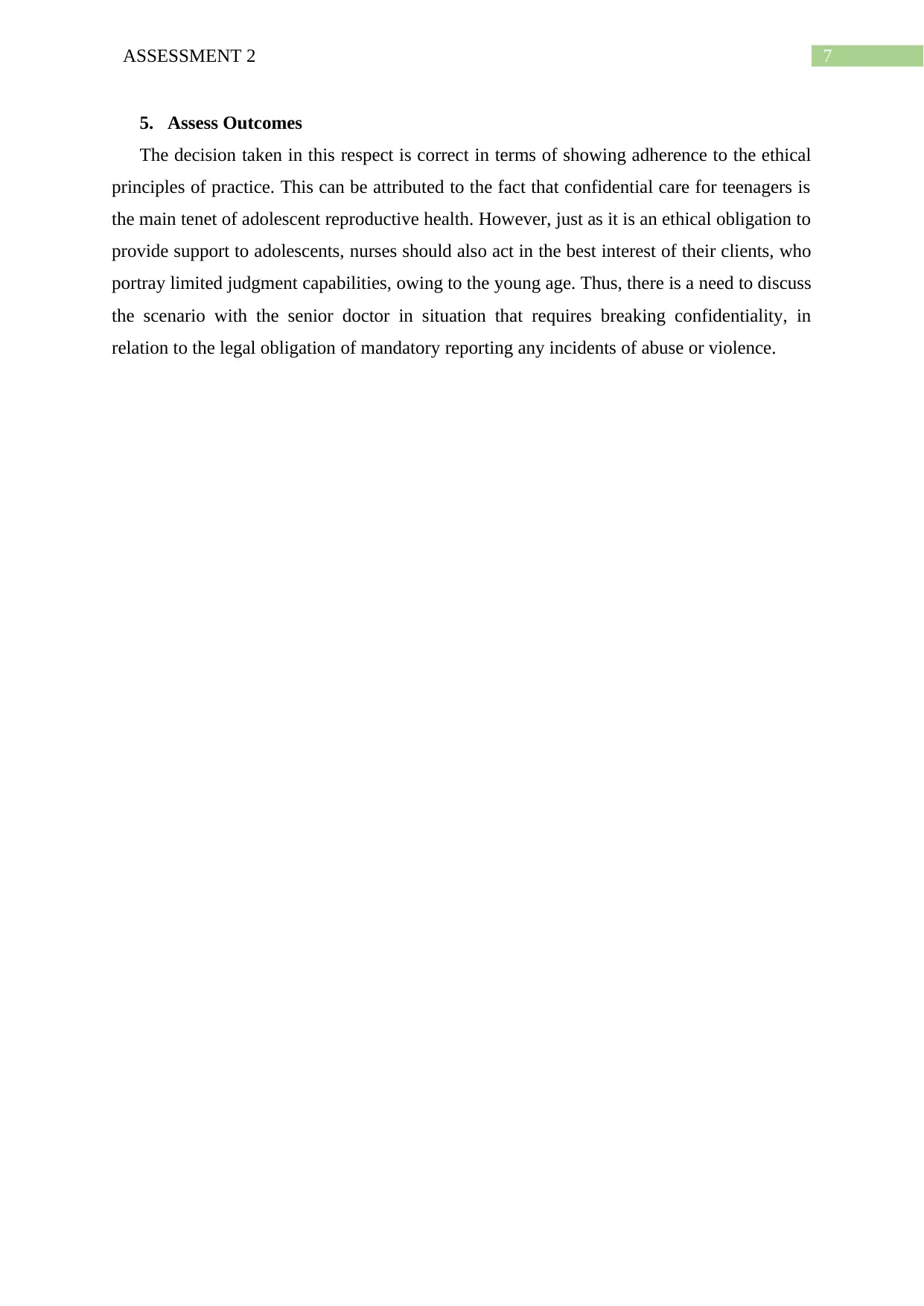
7ASSESSMENT 2
5. Assess Outcomes
The decision taken in this respect is correct in terms of showing adherence to the ethical
principles of practice. This can be attributed to the fact that confidential care for teenagers is
the main tenet of adolescent reproductive health. However, just as it is an ethical obligation to
provide support to adolescents, nurses should also act in the best interest of their clients, who
portray limited judgment capabilities, owing to the young age. Thus, there is a need to discuss
the scenario with the senior doctor in situation that requires breaking confidentiality, in
relation to the legal obligation of mandatory reporting any incidents of abuse or violence.
5. Assess Outcomes
The decision taken in this respect is correct in terms of showing adherence to the ethical
principles of practice. This can be attributed to the fact that confidential care for teenagers is
the main tenet of adolescent reproductive health. However, just as it is an ethical obligation to
provide support to adolescents, nurses should also act in the best interest of their clients, who
portray limited judgment capabilities, owing to the young age. Thus, there is a need to discuss
the scenario with the senior doctor in situation that requires breaking confidentiality, in
relation to the legal obligation of mandatory reporting any incidents of abuse or violence.
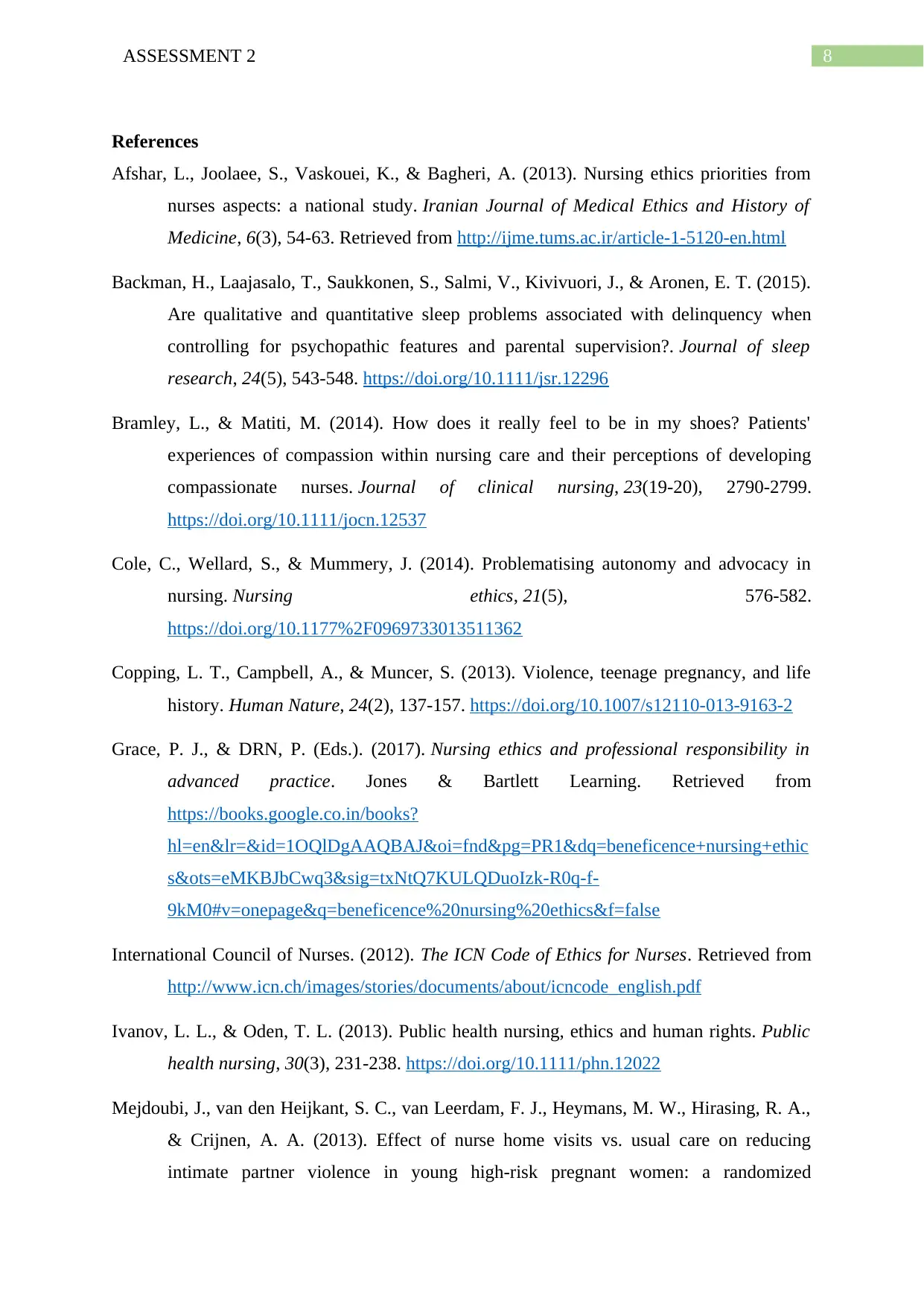
8ASSESSMENT 2
References
Afshar, L., Joolaee, S., Vaskouei, K., & Bagheri, A. (2013). Nursing ethics priorities from
nurses aspects: a national study. Iranian Journal of Medical Ethics and History of
Medicine, 6(3), 54-63. Retrieved from http://ijme.tums.ac.ir/article-1-5120-en.html
Backman, H., Laajasalo, T., Saukkonen, S., Salmi, V., Kivivuori, J., & Aronen, E. T. (2015).
Are qualitative and quantitative sleep problems associated with delinquency when
controlling for psychopathic features and parental supervision?. Journal of sleep
research, 24(5), 543-548. https://doi.org/10.1111/jsr.12296
Bramley, L., & Matiti, M. (2014). How does it really feel to be in my shoes? Patients'
experiences of compassion within nursing care and their perceptions of developing
compassionate nurses. Journal of clinical nursing, 23(19-20), 2790-2799.
https://doi.org/10.1111/jocn.12537
Cole, C., Wellard, S., & Mummery, J. (2014). Problematising autonomy and advocacy in
nursing. Nursing ethics, 21(5), 576-582.
https://doi.org/10.1177%2F0969733013511362
Copping, L. T., Campbell, A., & Muncer, S. (2013). Violence, teenage pregnancy, and life
history. Human Nature, 24(2), 137-157. https://doi.org/10.1007/s12110-013-9163-2
Grace, P. J., & DRN, P. (Eds.). (2017). Nursing ethics and professional responsibility in
advanced practice. Jones & Bartlett Learning. Retrieved from
https://books.google.co.in/books?
hl=en&lr=&id=1OQlDgAAQBAJ&oi=fnd&pg=PR1&dq=beneficence+nursing+ethic
s&ots=eMKBJbCwq3&sig=txNtQ7KULQDuoIzk-R0q-f-
9kM0#v=onepage&q=beneficence%20nursing%20ethics&f=false
International Council of Nurses. (2012). The ICN Code of Ethics for Nurses. Retrieved from
http://www.icn.ch/images/stories/documents/about/icncode_english.pdf
Ivanov, L. L., & Oden, T. L. (2013). Public health nursing, ethics and human rights. Public
health nursing, 30(3), 231-238. https://doi.org/10.1111/phn.12022
Mejdoubi, J., van den Heijkant, S. C., van Leerdam, F. J., Heymans, M. W., Hirasing, R. A.,
& Crijnen, A. A. (2013). Effect of nurse home visits vs. usual care on reducing
intimate partner violence in young high-risk pregnant women: a randomized
References
Afshar, L., Joolaee, S., Vaskouei, K., & Bagheri, A. (2013). Nursing ethics priorities from
nurses aspects: a national study. Iranian Journal of Medical Ethics and History of
Medicine, 6(3), 54-63. Retrieved from http://ijme.tums.ac.ir/article-1-5120-en.html
Backman, H., Laajasalo, T., Saukkonen, S., Salmi, V., Kivivuori, J., & Aronen, E. T. (2015).
Are qualitative and quantitative sleep problems associated with delinquency when
controlling for psychopathic features and parental supervision?. Journal of sleep
research, 24(5), 543-548. https://doi.org/10.1111/jsr.12296
Bramley, L., & Matiti, M. (2014). How does it really feel to be in my shoes? Patients'
experiences of compassion within nursing care and their perceptions of developing
compassionate nurses. Journal of clinical nursing, 23(19-20), 2790-2799.
https://doi.org/10.1111/jocn.12537
Cole, C., Wellard, S., & Mummery, J. (2014). Problematising autonomy and advocacy in
nursing. Nursing ethics, 21(5), 576-582.
https://doi.org/10.1177%2F0969733013511362
Copping, L. T., Campbell, A., & Muncer, S. (2013). Violence, teenage pregnancy, and life
history. Human Nature, 24(2), 137-157. https://doi.org/10.1007/s12110-013-9163-2
Grace, P. J., & DRN, P. (Eds.). (2017). Nursing ethics and professional responsibility in
advanced practice. Jones & Bartlett Learning. Retrieved from
https://books.google.co.in/books?
hl=en&lr=&id=1OQlDgAAQBAJ&oi=fnd&pg=PR1&dq=beneficence+nursing+ethic
s&ots=eMKBJbCwq3&sig=txNtQ7KULQDuoIzk-R0q-f-
9kM0#v=onepage&q=beneficence%20nursing%20ethics&f=false
International Council of Nurses. (2012). The ICN Code of Ethics for Nurses. Retrieved from
http://www.icn.ch/images/stories/documents/about/icncode_english.pdf
Ivanov, L. L., & Oden, T. L. (2013). Public health nursing, ethics and human rights. Public
health nursing, 30(3), 231-238. https://doi.org/10.1111/phn.12022
Mejdoubi, J., van den Heijkant, S. C., van Leerdam, F. J., Heymans, M. W., Hirasing, R. A.,
& Crijnen, A. A. (2013). Effect of nurse home visits vs. usual care on reducing
intimate partner violence in young high-risk pregnant women: a randomized
⊘ This is a preview!⊘
Do you want full access?
Subscribe today to unlock all pages.

Trusted by 1+ million students worldwide
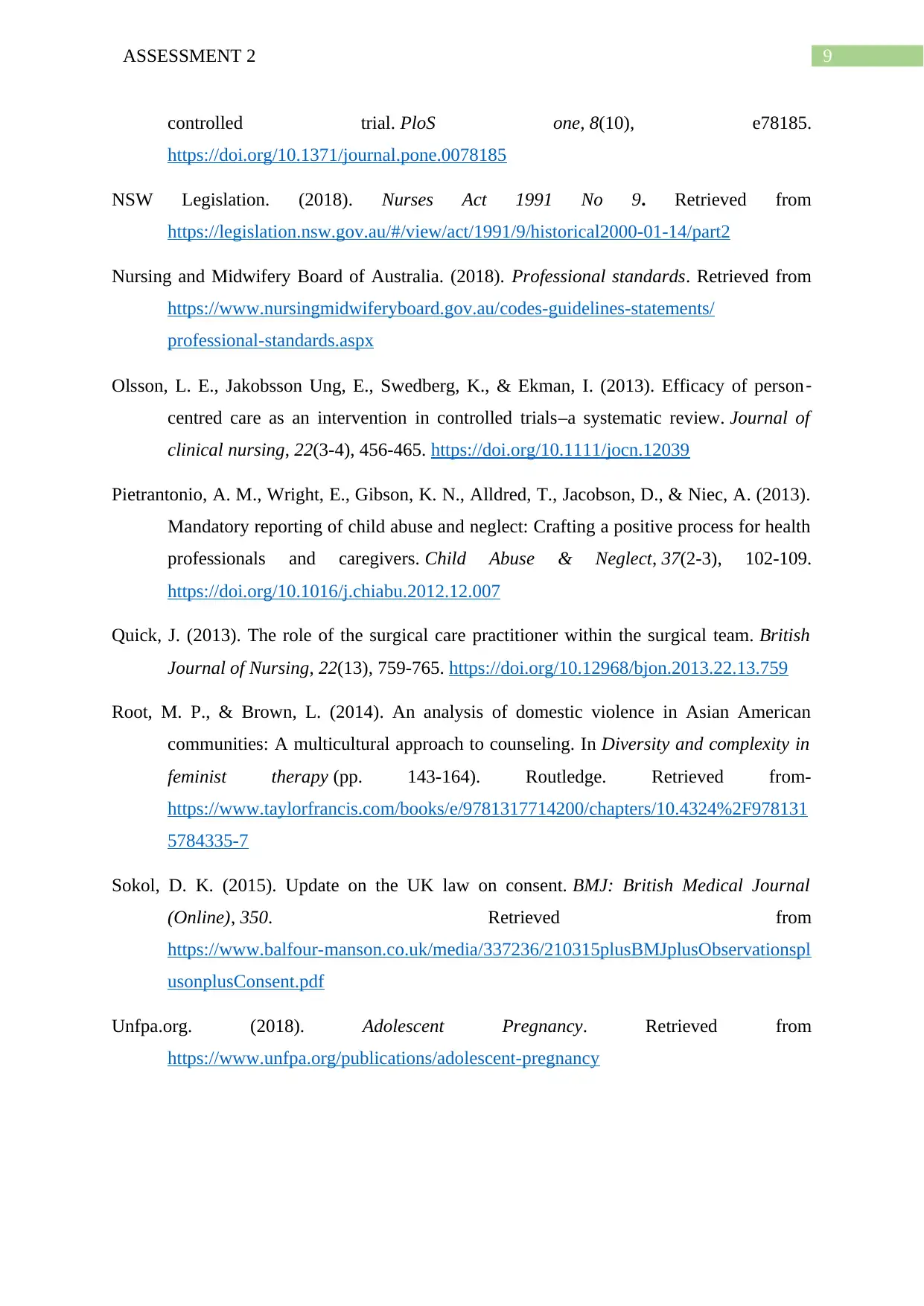
9ASSESSMENT 2
controlled trial. PloS one, 8(10), e78185.
https://doi.org/10.1371/journal.pone.0078185
NSW Legislation. (2018). Nurses Act 1991 No 9. Retrieved from
https://legislation.nsw.gov.au/#/view/act/1991/9/historical2000-01-14/part2
Nursing and Midwifery Board of Australia. (2018). Professional standards. Retrieved from
https://www.nursingmidwiferyboard.gov.au/codes-guidelines-statements/
professional-standards.aspx
Olsson, L. E., Jakobsson Ung, E., Swedberg, K., & Ekman, I. (2013). Efficacy of person‐
centred care as an intervention in controlled trials–a systematic review. Journal of
clinical nursing, 22(3-4), 456-465. https://doi.org/10.1111/jocn.12039
Pietrantonio, A. M., Wright, E., Gibson, K. N., Alldred, T., Jacobson, D., & Niec, A. (2013).
Mandatory reporting of child abuse and neglect: Crafting a positive process for health
professionals and caregivers. Child Abuse & Neglect, 37(2-3), 102-109.
https://doi.org/10.1016/j.chiabu.2012.12.007
Quick, J. (2013). The role of the surgical care practitioner within the surgical team. British
Journal of Nursing, 22(13), 759-765. https://doi.org/10.12968/bjon.2013.22.13.759
Root, M. P., & Brown, L. (2014). An analysis of domestic violence in Asian American
communities: A multicultural approach to counseling. In Diversity and complexity in
feminist therapy (pp. 143-164). Routledge. Retrieved from-
https://www.taylorfrancis.com/books/e/9781317714200/chapters/10.4324%2F978131
5784335-7
Sokol, D. K. (2015). Update on the UK law on consent. BMJ: British Medical Journal
(Online), 350. Retrieved from
https://www.balfour-manson.co.uk/media/337236/210315plusBMJplusObservationspl
usonplusConsent.pdf
Unfpa.org. (2018). Adolescent Pregnancy. Retrieved from
https://www.unfpa.org/publications/adolescent-pregnancy
controlled trial. PloS one, 8(10), e78185.
https://doi.org/10.1371/journal.pone.0078185
NSW Legislation. (2018). Nurses Act 1991 No 9. Retrieved from
https://legislation.nsw.gov.au/#/view/act/1991/9/historical2000-01-14/part2
Nursing and Midwifery Board of Australia. (2018). Professional standards. Retrieved from
https://www.nursingmidwiferyboard.gov.au/codes-guidelines-statements/
professional-standards.aspx
Olsson, L. E., Jakobsson Ung, E., Swedberg, K., & Ekman, I. (2013). Efficacy of person‐
centred care as an intervention in controlled trials–a systematic review. Journal of
clinical nursing, 22(3-4), 456-465. https://doi.org/10.1111/jocn.12039
Pietrantonio, A. M., Wright, E., Gibson, K. N., Alldred, T., Jacobson, D., & Niec, A. (2013).
Mandatory reporting of child abuse and neglect: Crafting a positive process for health
professionals and caregivers. Child Abuse & Neglect, 37(2-3), 102-109.
https://doi.org/10.1016/j.chiabu.2012.12.007
Quick, J. (2013). The role of the surgical care practitioner within the surgical team. British
Journal of Nursing, 22(13), 759-765. https://doi.org/10.12968/bjon.2013.22.13.759
Root, M. P., & Brown, L. (2014). An analysis of domestic violence in Asian American
communities: A multicultural approach to counseling. In Diversity and complexity in
feminist therapy (pp. 143-164). Routledge. Retrieved from-
https://www.taylorfrancis.com/books/e/9781317714200/chapters/10.4324%2F978131
5784335-7
Sokol, D. K. (2015). Update on the UK law on consent. BMJ: British Medical Journal
(Online), 350. Retrieved from
https://www.balfour-manson.co.uk/media/337236/210315plusBMJplusObservationspl
usonplusConsent.pdf
Unfpa.org. (2018). Adolescent Pregnancy. Retrieved from
https://www.unfpa.org/publications/adolescent-pregnancy
1 out of 10
Related Documents
Your All-in-One AI-Powered Toolkit for Academic Success.
+13062052269
info@desklib.com
Available 24*7 on WhatsApp / Email
![[object Object]](/_next/static/media/star-bottom.7253800d.svg)
Unlock your academic potential
Copyright © 2020–2025 A2Z Services. All Rights Reserved. Developed and managed by ZUCOL.





